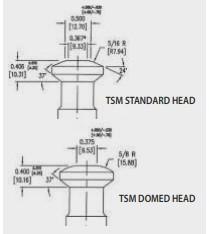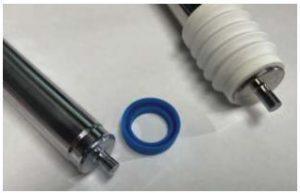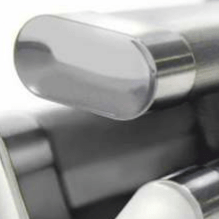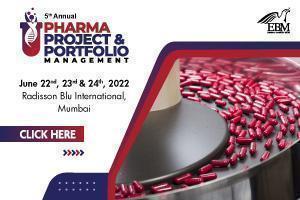
Choices among punch heads, barrels, and tips – as well as in die shapes and materials – can help fine-tune tableting
The basics of rotary tablet compression tooling have stood the test of time. However, the specifications of tooling design have become more sophisticated. The development of punch and die modifications – known as tooling options –provides ways to address tablet production-related issues (e.g., sticking, picking, and capping) as well as methods to reduce wear, extend tool life, and improve overall press operation. Here are some common options for addressing tablet production problems and optimizing performance:
Punch Head Options
The head is a critically important part of any rotary punch, as it comes in direct contact with the pressure roll and transmits the force necessary to form a tablet. The punch head is subjected to extreme pressure, friction, mechanical wear, and heat. Choosing the optimal head options for each product and process can significantly impact tablet quality, press performance, and tooling life.
Domed Head: Per the American Pharmacists Association’s® Tablet Specifications Manual (TSM), the standard rotary punch head features an angled surface on the top that transitions into a flat plane (head flat). As this head passes under the pressure rolls of the machine, this head design results in unnecessary stress at the intersection where the angle meets the flat. The TSM standard head design predates Computer Numerical Control (CNC) machinery, when complex geometric profiles were much more challenging to manufacture. With the current CNC and Computer Aided Design (CAD) modeling technology, head designs can be vastly improved. The TSM’s “domed” punch head replaces the angled surface with a radius that creates a much smoother transition to the head flat. This results in less stress and wear on the head, which reduces pressure roll fatigue and the propensity for head pitting.
EU-Specific Punch Head: The EU punch head’s profile looks similar to the domed head. However, today’s EU head actually predates the TSM domed head. The EU head is designed for EU presses using EU spec cams. Note that this head should only be used on presses that are equipped with cams cut specifically for this head design.
Extended Head Flats: Some products/formulations are dwell-time sensitive and can benefit from extended dwell times. As dwell time is relative to the turret pitch circle, press speed, and head flat diameter, dwell time can only be increased by slowing the press speed or increasing the head flat diameter. As slowing the press will decrease production, increasing the head flat is often the best option. As the name implies, the extended head flat option extends the head flat by making a slight modification to the head’s geometry. This modification can extend dwell time by up to 40%, typically without requiring any additional parts. (Note that the extended head flat can be applied to both B and D type tooling and both TSM domed and EU head profiles.)
Rotating/Replaceable Head: This tooling option features a punch head and punch body that are made as separate pieces. The head design features a grooved stem held in place with coiled spring pins, which allow the head to rotate independently of the punch body. This option is most often applied to multi-tip micro-tab tooling, as it was invented to alleviate the torsional force that results from drag on the lower punch heads as they pass through the cams and pressure rolls. Additionally, this feature evenly distributes headwear via head rotation that is independent of the punch barrel. Rotating heads normally utilize a non-food grade grease for lubrication, so the rotating head is almost exclusively seen on lower punches (i.e., below the die table).
Fixed Indexable Head: Like the rotating head option mentioned earlier, this design also features the head and punch body made as separate parts. This punch option was designed to extend the wear life of a punch head. As punch heads track through cams in only one direction, most of the wear is concentrated in one small area. The indexable head design allows the head to be disassembled, rotated, and reassembled by the user, providing a “new” portion of the head oriented toward press rotation. This head designis secured with a heavy-duty coiled spring pin and can be rotated three times, potentially quadrupling the life of the head. Finally, with both the rotating and indexable head designs, the materials of the head and punch body can be optimized independently to achieve different goals for each component. For example, a high-chrome steel with enhanced product-release characteristics may work for the tip and body while a more wear-resistant material, such as M2 steel, may best benefit the head.
Mirror Finish Punch Heads: The punch head is polished to a very smooth, mirror-like finish for reduced friction and heat generation. This can be especially useful in high-speed presses with soft cam materials, such as bronze or Delrin. A mirror finish on the punch head can also help to maintain the quality and integrity of the punch head lubricant.


Punch Barrel Options
Dust Cup or Bellows Groove: Dust cups or bellows can prevent lubricating oil from contaminating the powder in the feeder and/or the tablets themselves. They also can thwart dust from contaminating the lubricated parts of the punches. Using a groove machined onto the punch barrel allows the press technician to quickly install pre-formed dust cups or bellows onto the punches, reducing the risk of contaminated tablets and saving time during setup by eliminating the step of punching a hole in individual tip-mounted dust cups. These prefabricated grooves easily allow the cup or bellows to be placed into the proper position and help to retain that position during operations.
Key for Interchangeability (Natoli Align-Pro): As press downtime equates to decreased production and lost profits, simplifying tool installation is advantageous. Typically, for non-round tablets, each upper punch is used to set each die at each turret station. However, manufacturing the upper punches to have a special key angularity tolerance will allow for the use of a single-die alignment/installation tool (i.e., Natoli Align-Pro). This is a special tool that singularly allows the press operator to set all of the dies, as well as to install any upper punch in any turret station without further alignment. This can significantly accelerate press setup, decrease the potential for setup errors that risk damage to the upper punches and, ultimately, increase production.
Special Key Position: Although overall punch dimensions are largely standardized, the linear placement of the key on upper punches can vary depending on the press’s make and model. When this component provides the only variation among toolsets, it can complicate tooling inventory and require additional equipment. However, using a special-length key at a unique location on the barrel can often mitigate this issue and allow the same toolset to be utilized on multiple press models. This can simplify tooling inventory and allow for flexibility when scheduling production.
Special Key Angle: In addition to the linear placement of the key on the punch barrel, the key angle relative to the punch tip shape is another variation among tablet press models. Variability in key slot orientation on the press, rotation of the press (CCW or CW), and tablet takeoff orientation all influence which key angle to apply. When ordering new tooling, always provide the tool vendor with the tablet press make and model you intend to use to ensure the appropriate key angle is applied to the tool set.
Mirror Finish Punch Barrels: Providing punches with a mirror finish on the barrels can reduce friction, heat, and wear on both the punches and the punch guides. This helps preserve the integrity of the punch lubrication, especially on high-speed presses.
Punch Tip Options
Reduced-Tip Width: This modification to the lower punch tip reduces the area of the tip that comes in contact with the die bore. As a result, friction and heat are reduced, which can minimize sticking in products that contain ingredients with low melting points.
Double Deep Relief (increased-relief depth): With this option, the relief depth on the lower punch is increased, providing more clearance between the die bore and stem of the lower punch. Using this punch modification reduces the propensity for punch binding and improves the lower punch tip’s ability to scrape the die bore clean on the down stroke. This tool modification works especially well for products that tend to cause punch tip binding in the die bore. The narrow tip width and increased relief depth are often used in combination, as they increase the efficacy of each other.
Die Options
Die Taper: This slight conical profile feature increases the size of the bore on either or both sides of the die. Die taper can be applied to both sides of the die so that the die can be flipped over when one side wears out, therefore doubling the life of the die, or it can be applied to just one side, providing the ability to trial both a tapered and untapered side. Dies can be tapered using the TSM standard taper dimensions of 0.003” wide x 0.188” deep (0.08 x 4.75 mm) or customized for specific applications or products.
Die bore taper has two major functions: to provide space for entrapped air to escape and to reduce ejection force. As entrapped air is often at least partially responsible for capping and delamination issues, die taper can create a more spacious opening and be effective in eliminating these defects. Likewise, the increased space created by die taper can reduce defects, such as cracking and delamination, created by ejection force by allowing the tablet to begin expanding sooner. Additionally, die taper can help guide the upper tip into the die bore, which is useful for preventing chipping damage and J-hook formation when the upper tip and die bore of a press are even slightly misaligned.
Undercut Dies: For medium- and large-sized tablets, the maximum compression force rating is relative to the tablet’s overall size and the curvature of the cup. For very small tablet sizes (typically ≤5/32 in. or 4 mm), however, the maximum force rating is determined by the propensity of the lower punch tip to bend or buckle, which is proportional to the tip length. Undercut dies allow for the use of shortened and thus strengthened lower punch tips, increasing the maximum permissible force and achieving the desired tablet hardness.
While this process can yield more favorable production outcomes, using it requires the press to be equipped with shallow fill cams and effective lower punch retainers.
Punch and Die Steels & Liners
Punch and die steels are often referred to as“Standard” or “Premium.” These terms originated in the early 1900s to differentiate pricing options and product types, largely for inventory purposes. However, they fail to describe the attributes of the steel, including its quality. Steel quality can be assessed by determining a specific alloy’s chemistry relative to the standard set for that grade of material, by inclusion content in each volume, and by mechanical properties such as Rockwell hardness or impact toughness. A reputable tool vendor should be able to provide documentation that validates the true quality of a tool steel.
Standard Steels (S7, S1, 408): These are shock-resistant grades for punches that are commonly used for many pharma products and are characterized by their excellent shock resistance and higher max force ratings.
High-Chrome Premium Steels (M340 & 440C): These high-chrome grades are most useful for sticky products, as they provide enhanced product release. Due to their chrome content, they also have good corrosion resistance much like traditional stainless steels. Typically, M340 is more useful as a punch steel due to its higher impact toughness and 440C is used for dies, as having a punch and die made from the same steel can increase the propensity for galling.
Premium Wear-Resistant Grades (D2, D3, K340, M2, A2): These are abrasion-resistant grades commonly used for compressing abrasive products or for extremely long runs, especially in the Nutra industry. Their alloy chemistry better resists the abrasive wear that causes degradation in cup finish and tip edge wear. Note D3 is the standard steel for dies, as dies do not experience the impact/shock loading conditions that punches do.
Particle Metallurgy (PM) Grades: These include PM 3V, PM9V and PM10V for punches and PM15V for dies. These are the most abrasion-resistant punch and die steels and are most frequently used in industrial tableting applications involving exceptionally abrasive products.
Carbide and Ceramic Liners: Dies are often subject to abrasion in the bore and the formation of wear rings when compressing challenging and abrasive products. Carbide or ceramic liners can be utilized to address these wear issues for products that warrant it.
 KEVIN QUEENSEN is a Mechanical Engineering and Technical Service Support Representative at Natoli Engineering Co.
KEVIN QUEENSEN is a Mechanical Engineering and Technical Service Support Representative at Natoli Engineering Co.
Mr. Queensen primarly focuses on specialty tablet and tooling designs along with determining new maximum compression force calculation methods and performing Finite Element Analysis (FEA).








